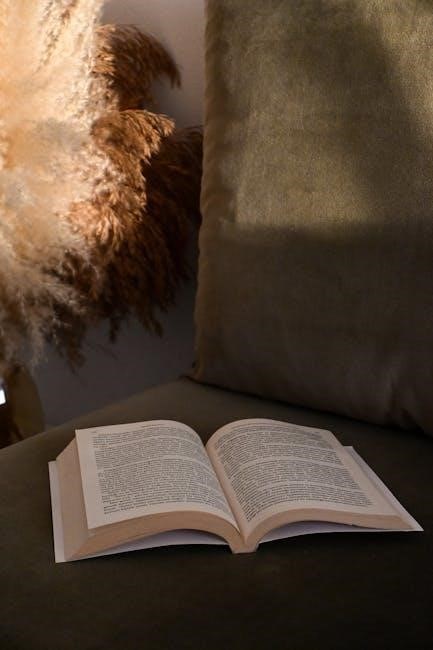The Book of Lilith is a captivating work of magical realism‚ blending myth‚ satire‚ and feminist themes․ It reimagines Lilith’s story‚ exploring empowerment‚ desire‚ and rebellion against patriarchal norms․
1․1 Historical Background of Lilith
Lilith‚ a figure deeply rooted in ancient mythology‚ first appears in texts like the Epic of Gilgamesh and the Dead Sea Scrolls․ In Jewish folklore‚ she is often depicted as Adam’s first wife‚ created equal to him but refused to submit‚ leading to her exile from Eden․ Over centuries‚ Lilith’s character evolved‚ with some traditions portraying her as a demon or Mother of Demons‚ while others celebrate her as a symbol of independence and female empowerment․ The Book of Lilith draws on these rich‚ complex narratives‚ reimagining her story for modern audiences while maintaining its historical and mythological essence․ Her legacy spans religious texts‚ literary works‚ and cultural interpretations‚ making her a timeless and multifaceted figure․
1․2 Literary Genre and Style
The Book of Lilith falls under the genre of magical realism‚ blending fantasy with satirical elements․ Its style is distinct‚ often described as a pseudo-academic framing story‚ which adds depth and intrigue․ The narrative is layered with scholarly references and fictional elements‚ creating a unique reading experience․ The prose is both lyrical and provocative‚ challenging traditional interpretations of Lilith’s myth․ By combining humor‚ satire‚ and philosophical inquiry‚ the book critiques patriarchal norms and societal structures․ The author’s use of vivid imagery and a satirical tone allows for a fresh exploration of Lilith’s character‚ making the text both entertaining and intellectually stimulating․ This blend of genres and styles sets The Book of Lilith apart as a thought-provoking and engaging read․

The Mythological Origins of Lilith
Lilith’s origins trace back to ancient Jewish folklore‚ where she is depicted as Adam’s first wife‚ symbolizing rebellion and empowerment․ Her story has evolved across cultures‚ blending myth and mystery․
2․1 Lilith in Jewish Folklore
In Jewish folklore‚ Lilith is often portrayed as a controversial figure‚ sometimes depicted as Adam’s first wife‚ created equal to him․ She is known for refusing to submit to Adam‚ symbolizing independence․ Lilith’s story varies across texts‚ with some describing her expulsion from the Garden of Eden and others associating her with demonic qualities․ Her character represents both empowerment and conflict‚ embodying themes of equality and rebellion․ These narratives have shaped her image in religious and cultural contexts‚ making her a complex and enduring symbol in Jewish tradition․
2․2 Evolution of Lilith’s Character
Lilith’s character has evolved significantly across cultures and traditions․ Originally depicted in ancient myths as a powerful‚ independent figure‚ she was often associated with darkness and mischief․ In Jewish folklore‚ Lilith was cast as Adam’s first wife‚ who refused to submit to him‚ symbolizing defiance and equality․ Over time‚ her image shifted‚ with some texts portraying her as a demonic figure‚ while others celebrated her as a symbol of female empowerment․ Modern interpretations‚ particularly in feminist literature‚ have reimagined Lilith as a complex‚ multidimensional character‚ emphasizing her strength‚ autonomy‚ and challenges to patriarchal norms․ This evolution reflects changing societal views on gender roles and the enduring fascination with her enigmatic presence․

Literary Analysis of The Book of Lilith
The Book of Lilith blends magical realism with satirical elements‚ offering a fresh perspective on the Lilith myth․ It challenges traditional narratives through its unique storytelling approach․
3․1 Magical Realism and Satirical Elements
The Book of Lilith masterfully combines magical realism with satirical undertones‚ creating a narrative that is both fantastical and thought-provoking․ By blending myth with contemporary themes‚ the book challenges traditional interpretations of Lilith’s story‚ presenting her as a complex‚ multidimensional character․ The use of magical realism allows readers to engage with Lilith’s world while reflecting on real-world issues like gender dynamics and power structures․ Satirical elements subtly critique societal norms‚ particularly patriarchal systems‚ through humorous yet sharp commentary․ This unique blend of genres makes the book a compelling read‚ offering entertainment while encouraging deeper reflection on themes of empowerment and rebellion․ The fusion of these literary styles ensures that Lilith’s story resonates with modern audiences‚ making it a standout work in its genre․
3․2 Narrative Structure and Style
The Book of Lilith employs a unique narrative structure‚ blending a pseudo-academic framing story with a reimagined mythological tale․ The discovery of lost scrolls in war-torn Iraq serves as a clever device to present Lilith’s story‚ creating a sense of historical authenticity․ The narrative transitions seamlessly between the framing story and Lilith’s first-person account‚ offering a dual perspective that enriches the reader’s understanding․ The prose is lyrical yet accessible‚ with vivid descriptions that bring Lilith’s world to life․ Dialogue is used sparingly but effectively‚ adding depth to character interactions․ The non-linear storytelling emphasizes Lilith’s evolution from a misunderstood figure to a symbol of empowerment․ This structure‚ combined with the book’s exploratory tone‚ invites readers to reflect on themes of creation‚ desire‚ and rebellion‚ making the narrative both engaging and thought-provoking․ The style is reminiscent of satirical fantasy‚ blending humor with sharp societal critiques․

Themes in The Book of Lilith
The Book of Lilith explores themes of creation‚ desire‚ and rebellion‚ challenging patriarchal norms while emphasizing empowerment and self-discovery through Lilith’s journey․
4․1 Creation and Desire
The Book of Lilith delves into the themes of creation and desire‚ reimagining Lilith as the first woman created by God‚ tasked with infusing the world with souls․ Her role contrasts sharply with Adam’s‚ who is focused on establishing order and laws․ The narrative explores Lilith’s autonomy and her refusal to submit to Adam’s sexual demands‚ particularly his insistence on the “Adam-on-top” position‚ symbolizing her rejection of patriarchal dominance․ Desire is portrayed as a complex force‚ driving both intimacy and conflict․ The book challenges traditional Creation myths‚ presenting Lilith as a symbol of feminine power and self-determination․ Through her story‚ the themes of creation and desire are intertwined‚ highlighting Lilith’s struggle for equality and her ultimate rebellion against oppressive structures․
4․2 Rebellion Against Patriarchal Norms
The Book of Lilith portrays Lilith as a symbol of defiance against patriarchal norms‚ refusing to accept a subordinate role to Adam․ Her rebellion is rooted in a demand for equality and mutual respect‚ challenging the hierarchical structure of Eden․ The narrative highlights her expulsion from the Garden as a consequence of her defiance‚ framing it not as a fall but as a liberation․ Lilith’s character embodies resistance against oppressive systems‚ making her a powerful feminist icon․ The book explores themes of autonomy‚ free will‚ and the struggle for gender equality‚ positioning Lilith’s rebellion as a necessary act of self-empowerment․ Through her story‚ the text critiques traditional patriarchal narratives‚ offering a fresh perspective on the origins of humanity and the role of women in society․

Character Analysis
The Book of Lilith delves into Lilith’s complexity‚ portraying her as a symbol of empowerment and defiance․ Her character challenges patriarchal norms‚ showcasing both strength and vulnerability․
5․1 Lilith as a Symbol of Empowerment
Lilith emerges as a powerful symbol of female empowerment‚ challenging patriarchal norms and assertively claiming her autonomy․ Her refusal to submit to Adam underscores her strength and independence‚ making her a beacon for women seeking liberation․ The narrative portrays her as a figure who embodies self-determination‚ rejecting societal expectations imposed upon her․ Through her defiance‚ Lilith becomes a timeless icon of resistance and self-ownership‚ inspiring readers to embrace their individuality and challenge oppressive structures․ Her character serves as a testament to the enduring struggle for equality and freedom‚ resonating deeply in contemporary feminist discourse․ This interpretation of Lilith not only reclaims her mythological legacy but also positions her as a modern-day heroine of empowerment․
5․2 Adam’s Role and Dynamics with Lilith
Adam’s role in The Book of Lilith is pivotal‚ as he represents the patriarchal order that Lilith challenges․ Their dynamic is marked by tension and conflict‚ particularly over issues of dominance and submission․ Adam‚ initially portrayed as rigid and traditional‚ struggles with Lilith’s independence and refusal to conform to his expectations․ Their relationship evolves from mutual curiosity to confrontation‚ highlighting the clash between societal norms and individual freedom․ Adam’s character serves as a foil to Lilith’s empowerment‚ illustrating the deep-seated power struggles inherent in their mythological bond․ Through their interactions‚ the narrative underscores themes of control‚ equality‚ and the consequences of rebellion․ Adam’s eventual realization of Lilith’s strength adds depth to his character‚ transforming him from an antagonist to a complex figure grappling with change․

Cultural and Feminist Implications
The Book of Lilith explores cultural and feminist themes by reimagining Lilith’s story as a symbol of female empowerment and autonomy‚ challenging patriarchal norms and societal expectations․
6․1 Women’s Empowerment and Lilith
Lilith emerges as a powerful symbol of women’s empowerment in The Book of Lilith‚ challenging patriarchal norms and advocating for equality․ Her refusal to submit to Adam underscores her autonomy and self-determination․ The narrative portrays Lilith not as a submissive figure but as a strong‚ independent being who demands respect and equal rights․ This reimagining resonates with modern feminist movements‚ offering a fresh perspective on gender roles and liberation․ By highlighting Lilith’s strength and resilience‚ the book becomes a testament to the enduring struggle for women’s rights and the importance of reclaiming female agency in both historical and contemporary contexts․
6․2 Challenging Patriarchal Structures
The Book of Lilith boldly confronts patriarchal structures by redefining Lilith’s role in traditional narratives․ Historically depicted as a rebellious figure‚ Lilith’s story in this text questions the dominance of male-centered paradigms․ By portraying her as a symbol of resistance‚ the book critiques the suppression of female voices and challenges the notion of male superiority․ Lilith’s refusal to conform to Adam’s authority serves as a metaphor for the broader struggle against patriarchal norms․ This narrative not only subverts traditional myths but also empowers readers to question and challenge existing power dynamics‚ offering a fresh perspective on gender roles and societal expectations․

Religious and Mythological Context
The Book of Lilith delves into ancient Jewish mythology‚ tracing Lilith’s origins as Adam’s first wife and her defiance of patriarchal authority․ Modern interpretations reimagine her as a symbol of empowerment‚ challenging traditional religious narratives and fostering a deeper understanding of her role in mythological and cultural contexts․
7․1 Lilith in Religious Texts
Lilith’s presence in religious texts is often shrouded in mystery and controversy․ In Jewish scripture‚ she is mentioned in the Alphabet of Ben Sira‚ where she is depicted as Adam’s first wife‚ created equal to him․ However‚ their relationship turns tumultuous due to her refusal to submit‚ leading to her expulsion from Eden․ The Zohar‚ a foundational text of Jewish mysticism‚ further elaborates on her role‚ portraying her as a figure of darkness and chaos‚ often associated with the night and the untamed aspects of human nature․ Despite her negative portrayal‚ Lilith’s story has been reclaimed in modern feminist interpretations‚ where she symbolizes independence and defiance against patriarchal structures․ Her evolving image reflects the broader cultural and religious shifts in understanding gender roles and power dynamics․
7․2 Modern Interpretations of Lilith
Lilith has evolved into a symbol of empowerment and feminism in modern interpretations․ She is often seen as a figure who defies patriarchal norms‚ embodying independence and self-determination․ In contemporary literature and art‚ Lilith is frequently portrayed as a strong‚ autonomous being who challenges traditional gender roles․ Her story has been reclaimed by feminist movements‚ highlighting her refusal to submit to Adam and her expulsion from Eden as acts of courage rather than disobedience․ Additionally‚ Lilith is celebrated in some spiritual practices as a goddess of magic‚ sexuality‚ and liberation․ Modern interpretations also explore her duality‚ depicting her as both a nurturing mother figure and a force of chaos․ This reimagining of Lilith reflects a broader cultural shift toward embracing complexity and rejecting rigid societal expectations․

The Book of Lilith and Modern Audiences
The Book of Lilith resonates with modern audiences by exploring themes of empowerment and challenging patriarchal norms‚ making it a relevant and thought-provoking read in today’s society․
8․1 Relevance in Contemporary Society
The Book of Lilith holds significant relevance in contemporary society‚ offering a fresh perspective on feminist themes and empowerment․ Lilith’s story challenges patriarchal norms‚ resonating with modern movements advocating for gender equality and self-empowerment․ Her portrayal as a strong‚ independent figure who defies societal expectations appeals to readers seeking inspiration for personal autonomy․ The book’s exploration of desire‚ creation‚ and rebellion aligns with current conversations about identity and freedom․ By reimagining Lilith’s myth‚ the narrative encourages readers to question traditional power structures and embrace individuality․ This makes The Book of Lilith a compelling read for those interested in feminist literature and cultural critique‚ ensuring its enduring appeal in today’s diverse and evolving world․
8․2 Reader Reception and Reviews
The Book of Lilith has garnered diverse reader reception‚ with many praising its unique blend of magical realism and satirical elements․ Readers appreciate its thought-provoking narrative‚ which challenges traditional perspectives on gender and power․ The book’s feminist themes resonate strongly‚ particularly its portrayal of Lilith as a symbol of empowerment․ Some reviewers highlight its ability to balance entertainment with intellectual depth‚ making it a compelling read for those interested in literary fiction․ However‚ a few readers find the unconventional narrative structure confusing․ Overall‚ the book has been well-received for its bold storytelling and relevance to contemporary discussions on identity and societal norms‚ solidifying its place in modern feminist literature․

Historical and Academic Perspectives
The Book of Lilith offers a fresh lens on ancient myths‚ with scholars praising its exploration of Lilith’s evolution from a demonic figure to a feminist icon‚ reflecting cultural shifts in her interpretation․
9․1 Academic Analysis of the Book
Scholars have praised The Book of Lilith for its innovative blend of magical realism and satire‚ offering a profound exploration of feminist themes and mythological reinterpretation․ The narrative’s deconstruction of patriarchal norms and its portrayal of Lilith as a symbol of empowerment have sparked academic interest‚ particularly in gender studies․ Researchers highlight the book’s ability to challenge traditional religious and literary narratives‚ providing a fresh perspective on Lilith’s character․ The text’s use of pseudohistorical framing adds depth‚ inviting readers to reflect on the intersection of mythology and modernity․ Academic critiques often focus on the book’s thematic richness‚ its subversion of traditional gender roles‚ and its contribution to feminist literature․ This analysis underscores the work’s relevance in contemporary scholarly discussions on identity‚ power‚ and cultural reinterpretation․
9․2 Cultural Significance and Impact
The Book of Lilith holds profound cultural significance‚ reshaping perceptions of Lilith as a symbol of feminine power and rebellion․ By challenging patriarchal narratives‚ the book has become a catalyst for feminist discourse‚ inspiring readers to rethink traditional gender roles and religious myths․ Its exploration of empowerment and identity resonates across diverse communities‚ fostering conversations about equality and self-determination․ The text’s blend of mythology and modernity has also influenced contemporary literature‚ encouraging new interpretations of ancient stories․ As a cultural icon‚ Lilith embodies resistance and autonomy‚ making the book a cornerstone in discussions about gender‚ religion‚ and identity․ Its impact extends beyond literature‚ inspiring art‚ spirituality‚ and social movements‚ cementing its place as a transformative work in modern culture․

The Book of Lilith offers a compelling exploration of empowerment‚ rebellion‚ and identity․ Lilith’s story challenges patriarchal norms‚ inspiring readers to embrace autonomy and question traditional narratives․ Further reading is recommended to deepen understanding of her cultural and feminist significance․
10․1 Summary of The Book of Lilith
The Book of Lilith is a thought-provoking narrative that reimagines the myth of Lilith‚ often depicted as Adam’s first wife in Jewish folklore․ The story explores themes of empowerment‚ rebellion‚ and the struggle against patriarchal norms․ Lilith is portrayed as a powerful figure who challenges traditional roles and expectations‚ embodying themes of creation‚ desire‚ and autonomy․ The book blends elements of magical realism and satire‚ offering a unique perspective on Lilith’s character and her historical significance․ Through its engaging narrative‚ the book encourages readers to reflect on gender dynamics‚ cultural myths‚ and the enduring legacy of Lilith as a symbol of female strength and independence․ The text is both entertaining and intellectually stimulating‚ making it a compelling read for those interested in feminist and mythological themes․
10․2 Final Thoughts and Further Reading
The Book of Lilith offers a compelling exploration of Lilith’s myth‚ challenging readers to rethink her role in history and culture․ It is a powerful blend of storytelling‚ feminist themes‚ and mythological insights․ For those captivated by Lilith’s story‚ further reading can include works like The Lilith Scroll by B․L․ Marsh or scholarly articles on feminist theology․ Exploring modern interpretations of Lilith in literature and art can also deepen understanding․ Readers interested in magical realism and satire may find similar themes in works by authors like John Barth․ This book is a must-read for anyone drawn to stories of empowerment‚ rebellion‚ and the reclamation of female agency in cultural narratives․
